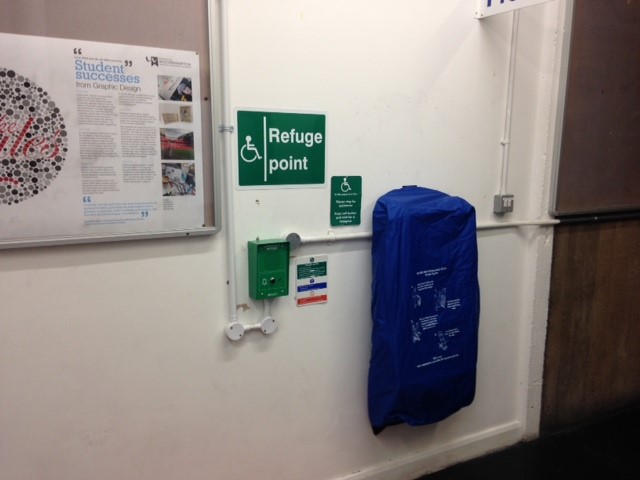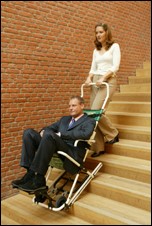The University of Wolverhampton is committed to promoting access for people who have a disability or long-term medical condition. This includes consideration of the requirements to enable effective evacuation of buildings in an emergency.
The University of Wolverhampton is required to ensure that all users of its buildings (including Halls of Residence) are able to escape safely in the event of an emergency. This includes having a capability to allow all occupants to evacuate safely without external assistance e.g. The Fire Service.
For most occupants of buildings, an emergency evacuation will simply be by means of them reacting to the warning signal and then making their way out of the building by the nearest available exit, in accordance with the University Emergency Evacuation Procedure.
However, some people, for example individuals who rely upon a wheelchair, may not be able to descend a staircase without assistance. For these people it may be necessary to provide a refuge on all storeys.
A refuge is an area that is both separated from a fire by fire-resisting construction and which has access via a safe route to a storey exit. It provides a temporarily safe space for individuals who are unable to leave the building unaided to wait for others to help them evacuate (source – Fire Safety an Employer’s Guide HSE publications).
It is also important to remember that there may be some buildings where safe refuge areas cannot be, or have not been provided due to the building design, currently these are listed in Appendix B (along with the reasons why):
Individuals who are permanently or temporarily unable to make their own way out of buildings in the event of an emergency are required to understand the following.
It is important that you (and if applicable your helper/support worker), familiarise yourself with the buildings that you use, remember this may include areas you only visit on a short-term basis e.g. Libraries , Sports Hall, Students Union etc.
Familiarise yourself with the exit routes and any refuges in your area. A full list of refuges will eventually be available electronically, however it is essential that you physically know where they are located. It is also important to remember that not all buildings (Appendix B) are currently equipped with refuge areas so it is vital that you find out in advance where these are.
If you are unsure or unable to identify the refuge areas, speak to a member of staff or the Facilities Manager (see Appendix A) who will be able to inform you of their exact locations. Refuge points are identifiable by locating the sign below.
All official Refuge areas will have an emergency voice communications (EVC) point placed within them in order for individuals to talk to University staff that will be co-ordinating any evacuation. It is important to know how to operate these communications, information about which can also be obtained from the Facilities Manager (see Appendix A). This is an image of what a refuge area will typically look like; the EVC is in the centre, underneath the refuge point sign.

Any individual who will have difficulty in evacuating a building without assistance should have completed a Personal Emergency Evacuation Plan (PEEP) in conjunction with the appropriate person from their Faculty or Service Department. Further information on PEEPs can be found in the Personal Emergency Evacuation Plan (PEEP) and Procedure, which can be obtained from the University Health and Safety Department web-site or through Student Support and Wellbeing (SSW).
If you are unable to use a stairwell without assistance you should make your way to the nearest available refuge point.
Using the communications point within the refuge inform Security in the Central Control Room of exactly where you are within the building.
At this point you should be informed by The Central Control Room as to whether or not the emergency is real or false. If the emergency is real you should remain where you are, unless threatened by fire or other emergency, and await evacuation by members of staff from the /Security Teams who have been trained in the use of Evacuation Chairs. If the evacuation is a false alarm, you will be advised of the situation as soon as possible and given further instructions, which will usually be to remain where you are.
Evacuation Chair in action
If you are unable to locate the communications point, inform someone who is evacuating the building to notify the Fire Co-ordinator of your whereabouts. However, even if you do find the communications point it is advisable to ask someone e.g. fire marshal, colleagues, student helper etc., to inform the Co-ordinator as well.
Under no circumstances should a lift be used without Fire Service permission!
REMEMBER TO USE THE ‘EVACUATION FLOW CHART’, IN ANY EMERGENCY EVACUATION SITUATION. ALWAYS CONSIDER THE EVACUATION TO BE THE REAL THING; NEVER ASSUME THAT IT IS A FALSE ALARM!
Can you leave the building unaided in the event of an emergency evacuation?
If yes:
Leave by the nearest available exit and make your way to the Assembly Point
If no:
1) Make your way to your nearest available refuge point
2) Use the communication point to contact Security to inform them of your whereabouts
(Follow the instruction notice on the wall)
3) Upon speaking with Security await further instructions
4) If you are informed that the evacuation is a non-emergency situation i.e. false alarm, remain where you are and await further instructions from Security staff.
5) If you are informed that the evacuation is a REAL EMERGENCY, try to remain calm and await further instructions, this may involve evacuation from the refuge by trained members of the Security by evacuation chair.
Remember that throughout the emergency you can keep in constant contact with Security via the Communications point.
Useful telephone numbers
There may be occasions when there is no emergency but you require assistance, for example in the event of a lift breakdown. You may telephone the University Central control room on the following number:
Wolverhampton Campus Control Room: 01902 322106
University Buildings that do not currently have ‘safe refuge’ areas.
Halls of Residence:
- All Halls of Residence (with the exception of Randall Lines Halls), as none of these have lifts;
Wolverhampton City Campus
- The George (MG) Building – this building has no lift;
- ML Building;
- The Chaplaincy – Ground floor building only;
- The Apprentice Hub – this building has no lift.
- King Street;
Walsall Campus
- WC Building – this building has no lift;
- Students’ Union (WS) Building – this building has no lift;
- Faith Centre (WC) Building – currently only occupying the ground floor;
Telford Innovation Campus
- Priorslee Hall (SH) Building – this building has no lift.


/prod01/wlvacuk/media/departments/digital-content-and-communications/images-18-19/iStock-163641275.jpg)
/prod01/wlvacuk/media/departments/digital-content-and-communications/images-2024/250630-SciFest-1-group-photo-resized-800x450.png)
/prod01/wlvacuk/media/departments/digital-content-and-communications/images-18-19/210818-Iza-and-Mattia-Resized.jpg)
/prod01/wlvacuk/media/departments/digital-content-and-communications/images/Maria-Serria-(teaser-image).jpg)
/prod01/wlvacuk/media/departments/digital-content-and-communications/images-2024/241014-Cyber4ME-Project-Resized.jpg)
/prod01/wlvacuk/media/departments/digital-content-and-communications/images-18-19/210705-bric_LAND_ATTIC_v2_resized.jpg)